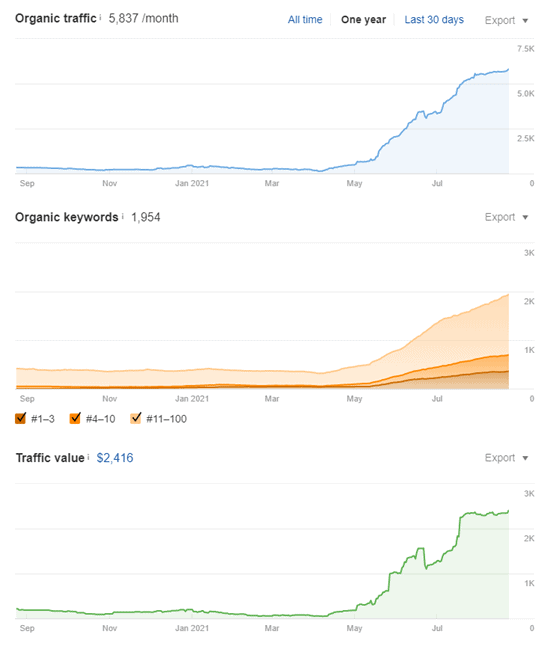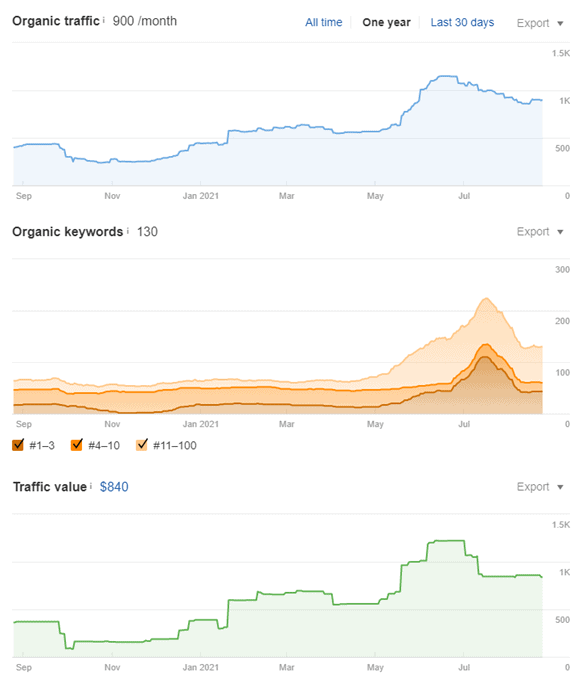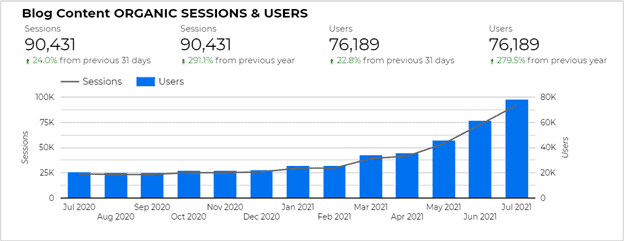With Google announcing core algorithm updates seemingly left and right, it’s hard for a digital marketer to keep up. But, if you’re in the medical space, there’s one modern SEO concept you really need to pay attention to.
E-E-A-T SEO.
This search ranking factor has been around since 2018, and our SEO experts have been testing and evaluating it ever since. With properly implemented strategies, we’ve found great success for our clients — including one who saw a 300% increase in organic revenue year over year.
In today’s blog, we’ll dive deeper into exactly what Google E-E-A-T is, how to optimize for it (using our client as an example), and what kind of results you can expect for your website.
Want a personalized plan to improve your website’s SEO performance using E-E-A-T? Request a free consultation today to see how Inflow can help.
What is E-E-A-T SEO?
E-E-A-T stands for Experience, Expertise, Authoritativeness, and Trustworthiness. The concept was introduced as part of Google’s ongoing efforts to deliver not just relevant content to its users, but also content that was accurate and trustworthy.
E-E-A-T SEO came into existence around the same time as the infamous 2018 Medic Core Update, which impacted many health and medical advice websites, including a few of our own clients. Other sites impacted included ones that fell into the “Your Money or Your Life” (YMYL) group.
Google’s goal was clear: When it comes to health, financial issues, legal advice, and safety, content needs to be top-notch and accurate to protect searchers.
But the E-E-A-T concept doesn’t just apply to copy on your website. It also applies to your blog authors, too.
The more credible and experienced your blog authors, the more trustworthy your site content will be deemed in turn. Author bios and pages became important real estate for communicating to Google experience, expertise, authority, and trustworthiness (so much so that you’ll be hard-pressed to find a blog without author pages nowadays).

We could go on for days about Google E-E-A-T, but, if you want to learn more, we recommend reading Moz’s thorough writeup on the subject and Google’s search quality rater guidelines.
The video below is hosted on YouTube. If you need assistance with viewing the video, please contact info@goinflow.com.
How to Improve E-E-A-T SEO: A Case Study
So, how does E-E-A-T SEO actually apply in the wilds of the internet?
In our work with clients covering YMYL topics, we’ve identified two strategies that really move the needle on this concept:
- Ensure you have high-quality content that is as accurate and medically sound as possible.
- Incorporate trusted medical experts into your content marketing strategy.
We’ll walk you through these two strategies in action with a real-world case study from one of our eCommerce clients (brand name withheld by request).
A little background: Prior to our partnership, this client failed to garner any growth in blog and foundational website content for more than a year. Because they were wholeheartedly entrenched in the health and wellness vertical, we hypothesized E-E-A-T SEO was the issue — and came up with a custom SEO proposal to address it.
Here’s what we did:
Step 1: Create accurate, medically sound content.
Thanks to E-E-A-T, all medical content (including health and wellness content) is heavily scrutinized by Google’s algorithm. Websites can be severely penalized by search engines when making medical claims, so any “medical” content must be approached carefully and with a detailed strategy.
To meet these standards (and, in turn, boost organic performance), our client needed to establish itself as an authoritative source for information in its industry — without selling “medical advice” and angering the Google gods.
There were a few key parts to our comprehensive SEO E-E-A-T approach for this client.
Update Top-Performing Content First
To get the most out of our E-E-A-T strategy, our SEO team began with the path of least resistance: updating older content that was already performing well but had much more opportunity for growth.
We knew that our client’s site had to have authority to grow its authority. So, rather than update poor-performing content, we started with the top 20 blogs already bringing in traffic and users. We double-downed on what was already working, optimizing for keywords and adding more detailed, helpful educational content to these blogs through our proven content refresh process.
SEO isn’t often an obvious cause-and-effect strategy, but it’s clear our content updates worked. On one particular piece of content updated in May 2021, traffic shot up by 1,100% month-over-month thanks to our changes.

Learn more about how refreshing content like this can help you appear in the AI Overviews and generate results like a 268% increase in organic clicks by reading our latest case study.
Linking to Authoritative Sources
Our comprehensive updates involved adding well-researched and informative content to the blog — and we wanted to make that obvious to Google with a top-notch external linking strategy.
In accordance with medical standards, every claim made on our client’s site is backed up with proof from credible and reliable sources of information like the National Institute of Health, academic and scientific journals, and published studies.
Step 2: Incorporate medical experts as content authors.
How else did we ensure our client’s content was medically sound?
By asking subject matter experts for some help.
Our strategy: Have objective, third-party medical experts review our website and blog content, and make it obvious to readers that all the content has passed medical muster.
We also avoided any schema markup that would mark that content as “medical information” to Google.
As part of this, we added a “Content Medically Reviewed By” box to every webpage, with the name of the associated contributor for that post. This markup sent signals to Google’s bots of the content’s credibility and authority, in adherence with E-E-A-T guidelines.
And it worked! Keyword footprints and organic traffic metrics quickly increased for updated blogs, as demonstrated in the Ahrefs graph below. This particular blog was updated in April 2021, and we began to see organic improvements not long after.

Creating an “About the Experts” Page
To further build trust and boost the credibility of the third-party experts reviewing this content, every “Content Medically Reviewed By” box on a web page links to an “About the Experts” web page. Here, readers (and Google’s bots) can find more information about these medical reviewers, including their qualifications and certifications.
With this “About the Experts” page, we signaled to Google that our client’s chosen experts were worth listening to — and worth a high rating from the quality score team.
The Results: E-E-A-T SEO is Worth the Work
With just a few months of E-E-A-T optimization under its belt, our client started seeing staggering results. And, when we look at the whole scope of the 14-month, 26-page project, it gets even better:
- 291% increase in organic sessions YoY
- 279.5% increase in organic users YoY
- 295% increase in clicks YoY
- 375% increase in organic impressions YoY
While all this is great, what really mattered to our client was the revenue numbers. Was the project worth the squeeze?
Most definitely.
Thanks to a 235% increase in organic goal completions year-over-year, our client saw a total 300% increase in organic revenue from this SEO content strategy alone!

The bottom line: Whether your business is firmly planted in or simply has a few products in the health and wellness industry, E-E-A-T SEO cannot be ignored. With just a few optimizations, you can take your content from passable to industry-leading — and Google will reward you for it.
Need help putting together your personalized E-E-A-T strategy? Our search engine optimization experts are always happy to help.
Request a free consultation anytime to learn how E-E-A-T and other SEO factors can boost your site’s SERP rankings, website traffic, and overall organic performance.










0 Comments